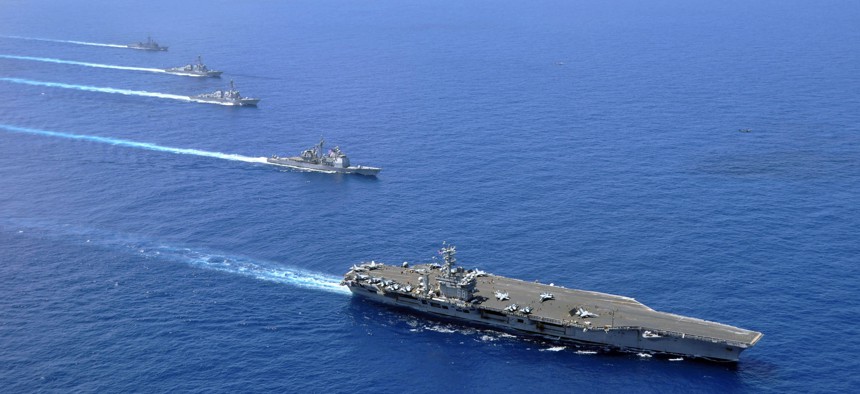
Aircraft carrier USS Nimitz, guided-missile cruiser USS Chosin, guided-missile destroyers USS Sampson and USS Pinkney, and guided-missile frigate USS Rentz operate in formation in the South China Sea. U.S. Navy photo by Mass Communication Specialist 1st Class David Mercil
Remember the Pentagon’s Pacific Pivot? It’s Still On
A new strategy document outlines Chinese activities in the South China Sea and the planned US responses to them.
The U.S. will continue sending new weapons and equipment to the Asia-Pacific region to counter China, U.S. Defense Department officials say. And in a new strategy document, the Pentagon said it would continue ignoring Beijing’s claims that reclaimed land in the South China Sea constituted sovereign territory.
Earlier this month, Chinese Foreign Minister Wang Yi said Beijing had halted land reclamation in the South China Sea. A senior defense official said it was unclear whether that was so.
“It’s not clear to us that they’ve stopped or if they’re finishing up,” David Shear, assistant defense secretary for Asian and Pacific security affairs, said at a Pentagon briefing Friday. “We will continue to watch that situation very closely and engage with the Chinese as we have in the recent past on the subject.”
The Pentagon touted its new congressionally mandated report as the “most comprehensive assessment of land reclamation activities in the South China Sea.” Over the past year, American officials, including Defense Secretary Ashton Carter, have stepped up their calls for China to halt such island-building. In May, the U.S. Navy released video of the manmade islands as well as recordings of radio calls of the Chinese military ordering a Navy spy plane to go away.
“[T]he United States will continue to fly, sail and operate wherever international law permits,” Carter said during a briefing at the Pentagon on Thursday. “As we've always the right to do, we will continue to do that, and none of this is going to change our conduct in anyway.”
The Pentagon says its aircraft and ships conduct “presence operations” regularly. “All of these efforts support our diplomatic efforts in the region,” Shear said. “We are looking at ways of further supporting our diplomatic effort including military activities.” He refused to discuss those future activities.
Shear said the U.S. military would continue to sail its ships and fly its planes through the South China Sea, but would not say whether these vessels and aircraft would come within the 12-mile territorial zone of the islands.
China is increasingly deploying its coast guard, not the PLA Navy, to “enforce its claims over features in the East and South China Seas,” the report says. Instead, it keeps its naval vessels out of sight, but “ready to respond to escalation.”
The U.S. argues that China has not “clearly defined the scope of its maritime claims in the South China Sea.” Beijing is not alone in its land reclamation in the South China Sea; Vietnam, Philippines, Taiwan and Malaysia have also built airstrips there. But China’s Fiery Cross Reef airstrip is far larger, boasting a nearly 10,000-foot runway, according to the Center for Strategic and International Studies. This could allow Beijing to base larger bomber aircraft on the island, drastically increasing the reach of its warplanes.
“The infrastructure China appears to be building would enable it to establish a more robust power projection presence into the South China Sea,” the Pentagon report says. “Its latest land reclamation and construction will also allow it to berth deeper draft ships at outposts; expand its law enforcement and naval presence farther south into the South China Sea; and potentially operate aircraft – possibly as a divert airstrip for carrier-based aircraft – that could enable China to conduct sustained operations with aircraft carriers in the area.”
The Islands will also allow longer deployment of non-military law enforcement ships.
“Potentially higher-end military upgrades on these features would be a further destabilizing step,” the report says.
“Of concern to us also … in addition to reclamation is the potential for further construction and the militarization of these features either by China or by the other claimants,” Shear said. “We call for permanent halt to all of those activities.”
Shear said the Philippines has “supported our position and we are working with [other claimants] in hope that they will do so as well.”
The Obama administration announced in 2012 that it would begin pivoting its military forces to the Pacific as it drew down troop levels in Afghanistan. But since then, thousands of U.S. forces have had to respond to other parts of the world, including Iraq, to stop the spread of Islamic State militants, and Europe, to participate in drills in response to Russia’s invasion of Ukraine.
But while ISIS and Russia have been grabbing global headlines, the pivot, or rebalance as the Pentagon prefers to call it, is still under way.
The Pentagon plans to deploy its newest ships and warplanes to the Asia-Pacific region. The report says many of the 395 F-35 Joint Strike Fighters to be built in the coming years will be deployed to the region. As well, more Navy ships and Air Force planes will head to the region, which already houses 368,000 military forces.





